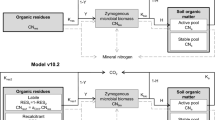Abstract
Most models for the turnover of soil organic matter (SOM) include a compartment that is either considered inert, or has a very slow turnover time (refractory SOM; RSOM). The RSOM content of soils varies markedly between sites, and knowledge of its size and variability are essential for determining whether soils behave as sources or sinks of atmospheric CO2. It has also been suggested that the accurate specification of RSOM pools is essential to modelling studies, and that uncertainty in estimates of the size of RSOM pool could be a major source of error in modelling soil organic C. In this paper, current SOM models are reviewed, and approaches to modelling RSOM and its significance are discussed. Simulations of SOM turnover for the Rothamsted Broadbalk winter wheat experiment using the Rothamsted C model and CENTURY are presented as examples.
Similar content being viewed by others
Author information
Authors and Affiliations
Additional information
Received: 13 July 1999
Rights and permissions
About this article
Cite this article
Falloon, P., Smith, P. Modelling refractory soil organic matter. Biol Fertil Soils 30, 388–398 (2000). https://doi.org/10.1007/s003740050019
Issue Date:
DOI: https://doi.org/10.1007/s003740050019




